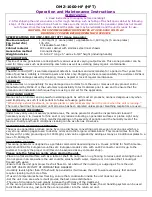
En-5
3. INSTALLATION WORK
1]
1
3.1. Selecting an installation location
Decide the mounting position with the customer as follows:
(1) Install the indoor unit level on a strong wall which is not subject to vibration.
(2) The inlet and outlet ports should not be obstructed: the air should be able to blow all
over the room.
(3) Install the unit a dedicated electrical branch circuit.
(4) Do
not install the unit where it will be exposed to direct sunlight.
(5) Install the unit where connection to the outdoor unit is easy.
(6) Install the unit where the drain pipe can be easily installed.
(7) Take servicing, etc. into consideration and leave the spaces shown in “3.1.1. Installation
dimensions”. Also install the unit where the filter can be removed.
Correct initial installation location is important because it is difficult to move the unit after it
is installed.
WARNING
• Install the indoor unit where is capable to support the weight of the unit. Secure the
unit firmly so that the unit does not topple or fall.
• Since this product is equipped with a refrigerant leakage sensor, embedded installa-
tion (with grating) is prohibited.
• Installing a grating may not be able to agitate the refrigerant sufficiently when the
refrigerant is leaked.
CAUTION
• Do not install the unit in the following areas:
- Area with high salt content, such as at the seaside. It will deteriorate metal parts,
causing the parts to fail or the unit to leak water.
- Area filled with mineral oil or containing a large amount of splashed oil or steam,
such as a kitchen. It will deteriorate plastic parts, causing the parts to fail or the
unit to leak water.
- Area where is close to heat sources.
- Area that generates substances that adversely affect the equipment, such as
sulfuric gas, chlorine gas, acid, or alkali. It will cause the copper pipes and brazed
joints to corrode, which can cause refrigerant leakage.
- Area that can cause combustible gas to leak, contains suspended carbon fibers or
flammable dust, or volatile in flammables such as paint thinner or gasoline.
- If gas leaks and settles around the unit, it can cause a fire.
- Area where animals may urinate on the unit or ammonia may be generated.
• Do not use the unit for special purposes, such as storing food, raising animals, grow-
ing plants, or preserving precision devices or art objects. It can degrade the quality of
the preserved or stored objects.
• Install the unit where drainage does not cause any trouble.
• Install the indoor unit, outdoor unit, power supply cable, connection cable, and
remote control cable at least 1 m away from a television or radio receivers. The
purpose of this is to prevent TV reception interference or radio noise.
(Even if they are installed more than 1 m apart, you could still receive noise under
some signal conditions.)
• If children under 10 years old may approach the unit, take preventive measures so
that they cannot reach the unit.
• When installing pipes shorter than 3m, sound of the outdoor unit will be transferred
to the indoor unit, which will cause large operating sound or some abnormal sound.
3. 1.1. Installation dimensions
Keep the distance between the wall hook bracket or indoor unit to the surrounding walls
as indicated in the following figure.
Remote
controller
Remote controller holder
Tapping screws (small, accessories)
(Wall cap)
50 mm or more
80 mm or more
100 mm or more
80 mm or more
150 mm or less
from the floor
3.1.2. Embedding the indoor unit in a wall
Upper air outlet
80 mm
or more
80 mm
or more
Lower air outlet
100 mm or more
Grating
PROHIBITED
When embedding the indoor unit in a wall, restrict the movement of the horizontal vane
for the upper air outlet so that it only operates horizontally. If this setting is not performed,
heat will build up in the wall and the room will not be cooled or warmed properly.
NOTE:
Explain the vane setting of direction only horizontally to the customer.
3.1.3. How to setting vane
Perform the “FUNCTION SETTING” according to the installation condition using the
remote controller. Please refer to “5. FUNCTION SETTING”.
1]
1
1]
1
3.2. Side panel L, R removal and installation
■
The intake grille removal
(1) Open the intake grille.
(2) Remove the rope.
(3) Lay down the intake grille, until the axle at the bottom of the intake grille is removed.
■
The intake grille installation
(1) The fixing axle of the intake grille is installed on the Panel.
(2) Lift the intake grille upward.
■
The side panel L, R removal
(1) Remove intake grille (Reference the intake grille removal.)
(2) Remove 4 screws.
(3) The middle finger is hung on the lower part as shown in the figure, and it pulls to the
front, pushing [
►
] mark, and bottom hooks (2 position) is removed from Base.
(4) The side panel is pulled to the front, raising the upper surface, and a side panel is removed.
■
The side panel L, R installation
(1) Firstly, fit the top part of the side panel, and insert top and bottom hooks.
(2) 4 screws is attached.
(3) The intake grille is attached.
Rope
Side panel R
Rope
Intake
grille
Front panel
Mounting shaft
Front panel
Intake grille
Side panel L
Screw
[
►
] mark
Side panel R
Base
Base
Side panel R
CAUTION
Install the side panel L, R and intake grille securely. If installation is imperfect, the side
panel L, R or intake grille may fall off and cause injury.
9378533080-04_IM.indb 5
9378533080-04_IM.indb 5
2022/2/14 15:13:14
2022/2/14 15:13:14
































